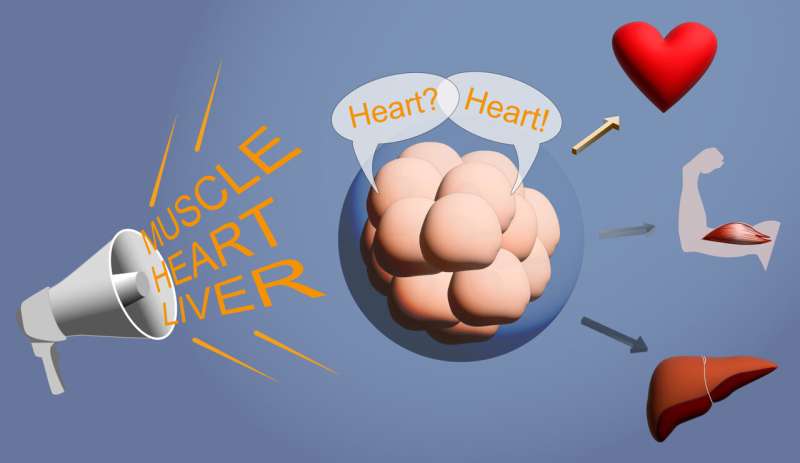This article has been reviewed according to Science X's editorial process and policies. Editors have highlighted the following attributes while ensuring the content's credibility:
fact-checked
trusted source
proofread
Scientists show how the signaling molecules BMP and FGF guide cell differentiation during embryonic development

Bricklayer, banker, teacher—choosing a career is one of the most exciting and important decisions in our lives. At the beginning of embryonic development, our cells are also faced with this decision. Some of them become blood cells, others muscle cells and still others become nerve cells.
A team led by Christian Schröter at the Max Planck Institute of Molecular Physiology in Dortmund has now unveiled how the antagonism between the two signaling molecules FGF and BMP influences the stem cells' career choice. Particularly interesting is the fact that stem cells can also direct their own fate. The findings are published in the journal Biology Open.
These findings help to better understand cell differentiation and could thus be a basis for future developments in the field of targeted culturing of tissue in cell replacement therapies.
People usually make their career choice in their teens. In the growing embryo, however, stem cells make this decision just a few days after the fusion of egg and sperm. At this point gastrulation begins and the so-called germ layers form. After gastrulation, the embryo can be thought of as an onion with three layers: the ectoderm, the mesoderm and the endoderm. These will later become the internal organs.
Cocktail of signal molecules
A cocktail of different signaling molecules such as BMP, FGF, Wnt and Nodal plays a decisive role in determining what a stem cell in the early embryo will eventually become. This cocktail is mixed by the surrounding extraembryonic tissue and—depending on its mixture—e.g., heart or nerve cells are formed.
The composition of the various signal cocktails is well understood. However, the role of one ingredient, fibroblast growth factor (FGF), which plays an important role in stem cell migration and growth, still remains unclear to a large extent. For the first time scientists led by Christian Schröter could show that FGF acts as an antagonist of the signal molecule BMP.
If there is little FGF, BMP has a strong effect and heart cells and extraembryonic mesoderm are more likely to develop. However, if there is much FGF, the effect of BMP is suppressed and cells of the posterior body axis are more likely to grow.

Instructive or intuitive?
In the past, parents played a decisive role in determining their children's career choices. In the development of stem cells, a similarly instructive process—based on the secretion of signaling molecules—was assumed by developmental biologists. However, the researchers' results indicate that stem cells are not exclusively guided by external signals, but can indeed take their fate into their own hands. Even if, for example, stem cells in the culture dish were instructed by continuous FGF addition to form heart cells, groups of completely different cell types developed nevertheless.
The scientists suspect that this supposedly intuitive process is a based on a community effect: Cells that are close together manage to communicate with each other. They send out signals themselves so that the neighboring cells develop in the same direction: They once become the same cell type and take up the same profession.
"Our research contributes to a better understanding of the process itself and the key players involved in cell differentiation," explains Christian Schröter. "In the future, these and other findings could help to generate specific cell types from stem cells in a targeted manner, for example to replace dead tissue after a heart attack. So far, selective culturing of specific cell types is not yet possible."
More information: Marina Gattiglio et al, Population-level antagonism between FGF and BMP signaling steers mesoderm differentiation in embryonic stem cells, Biology Open (2023). DOI: 10.1242/bio.059941
Provided by Max Planck Society





















